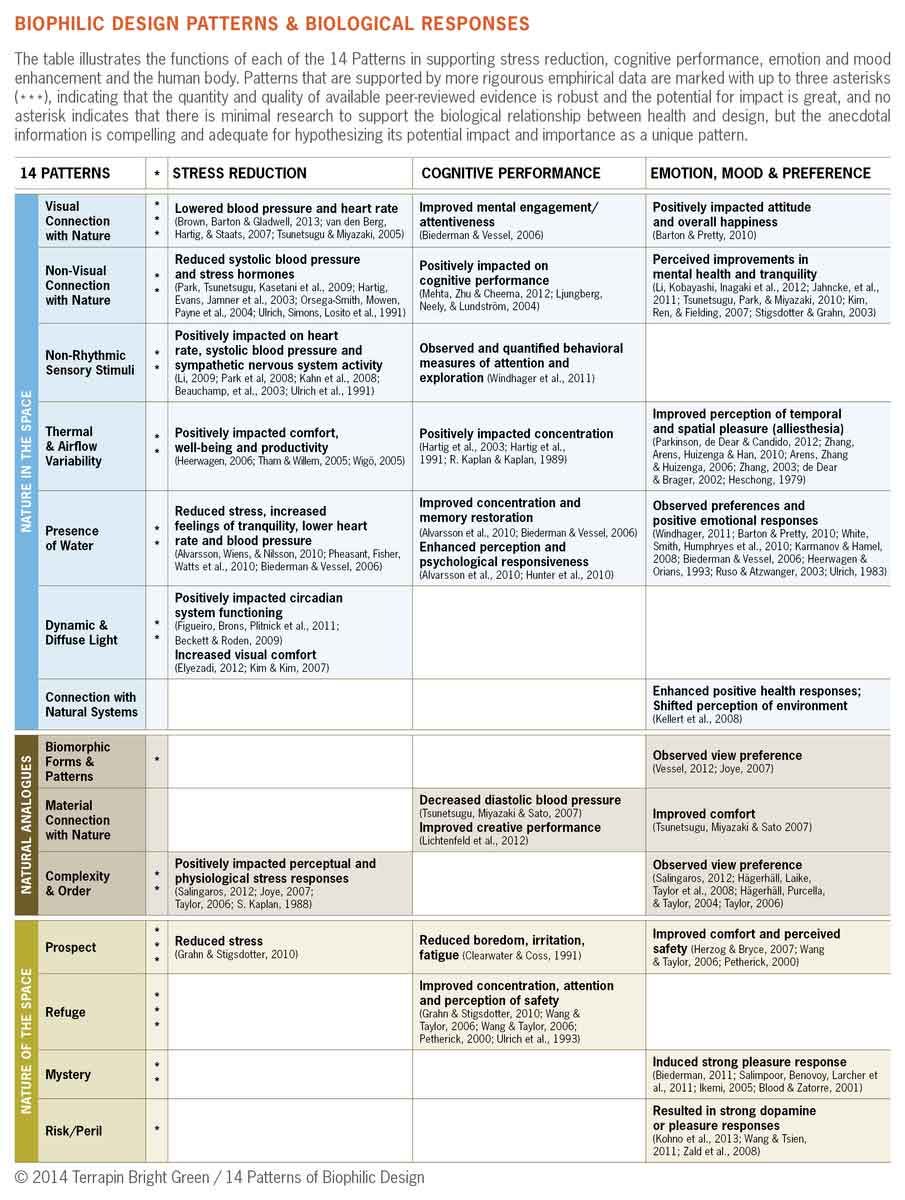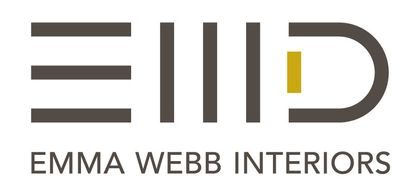
27/01/2020
How to Incorporate Biophilic Design in Your Home
Biophilia describes the instinctive bond between human beings and other living things – Nature nurtures, calms and inspires us.
Over two decades of research indicates that nature contact has a restorative effect on people, helping us deal with day-to-day stress and maintain our work performance.
Biophilic Design aims to create buildings that interact with the natural world and can be described in 14 patterns which have specific physiological, cognitive and emotional responses – see table below. Whilst there are no hard and fast rules, each pattern serves as guide to the design process and a way of incorporating a balance of natural elements and strategies to enhance our wellbeing.
Here are details of the 14 Biophilic Design Patterns and suggestions on how to incorporate them into your home:
1 Visual connection with nature
In other words, this is about seeing nature whilst indoors. Examples are orientating a room to benefit from a view of nature, hanging artwork depicting nature scenes, using lots of house plants (NASA recommends 1 per square meter) or even installing an aquarium or a green wall.
2 Non-visual connection with nature
This pattern is about stimulating our other senses – e.g. smell, sound, touch. Examples are using textured materials to decorate your home – stone, brick, wood, fur, natural fabrics, using essential oil diffusers (Dr Qing Li, the father of Forest Medicine would recommend pine oils) and listening to natural sound tracks ( Spotify has a good selection of nature sounds).
3 Non-rhythmic sensory stimuli
This pattern is about creating random movement and sometimes needs a bit of tech to replicate. Some examples are billowy fabric curtains that will move with a breeze, nature sounds set on a timer to come on infrequently, lamps timed to turn on and off to create shadows and even a desk fan also timed to rustle leaves of a potted plant sporadically.
4 Thermal and airflow variability
You don’t feel your best in a stuffy room, so this pattern is about creating a natural draft by bringing in fresh air (ensuring cross ventilation if possible) and either adjusting the heating or harnessing solar heat – i.e. opening and closing window shades or using a mix of building materials that absorb and emit the heat from the sun at different rates.
5 Presence of water
Not always easy to install a water feature within earshot, so artwork and digital sounds are great replicators for this pattern, as is an aquarium.
6 Dynamic and diffused light
You may already be familiar with circadian lighting – growing in popularity for contemporary office design – this emits a blue light during the morning (replicating the type of sunlight we have at this time) and slowly changes to warmer tones in the late afternoon. This pattern also takes inspiration from dappled light and shadows created in nature and recommends mimicking these fluctuations.
The simplest way to do this (beyond keeping the curtains open during the day and maximising natural light) is to use numerous light sources together (table lamps, ceiling pendants, spotlights, diffused wall lights) at different times of the day (smart bulbs are really handy to set this up) and different coloured bulbs 2700k (for warm afternoon light) 3000- 4000k for cool mid-morning light. Prisms can also be used to refract light and create dappled light effects.
7 Connection with natural systems
This describes an awareness and appreciation of natural change, for example the changing seasons, the time of the day, variable weather conditions and so on. We also see this in the patina of natural materials, geology (fossils, crystals) and life cycle patterns – house plants. Introducing this pattern into home design might include using patinated materials (leather, stone, wood, copper, bronze) or installing a decorative rain chain to harness the sound and view of rainwater.
8 Biomorphic forms and patterns
Biomorphic patterns and shapes occur naturally in nature, such as the Fibonacci sequence (a numeric sequence found in the number of petals in a flower or the pines of a cone) or Fractals (patterns that repeat at different scales – e.g. small branches of a tree replicating the larger pattern of the tree). Try using fabrics or wall papers with natural themes, natural materials and textures.
9 Material connection with nature
This is all about using a variety of natural materials and textiles. Studies have shown that if a room is finished mostly in wood, that it creates a feeling of relaxation, much like that of a spa – not great however if this is your home office space! Using a natural colour palette also brings this pattern to life in the home. Japandi one of the interior trends for this year is a great source of inspiration for achieving this pattern.
10 Complexity and order
This involves recreating natural spatial hierarchies and adding sensory layers, in other words building a rich and diverse material palette whilst also maintaining balance and symmetries in the floor plan. Fractal patterns can be found in Classical, ancient Mayan and Egyptian art which are a useful source of inspiration.
11 Prospect
This pattern focusses on having an unimpeded view over a distance (ideally 6 meters), in other words being able to see a piece of art at the end of a long corridor or having unimpeded exterior views through transparent materials (glass balcony railings). Try also using artwork representing this to fulfil this pattern.
12 Refuge
This is about creating a safe-haven in your home which is stress free and restorative. This can be done by including a high-backed chair, a reading nook, a dropped ceiling or even by simply lowering the lighting levels.
13 Mystery
The mystery pattern entices with the promise of more, it creates a feeling of anticipation and compels you to investigate further. Japanese garden designers are masters at this pattern and it is evident in various mazes and labyrinths around the world. It can be recreated at home by creating dramatic shadows with spotlights that might obscure part of a focal subject or using translucent materials at windows or doors that hint at what is beyond.
14 Risk and peril
This is an odd one for the home! Its about giving an experience of risk or danger whilst ultimately knowing that you are safe. Life sized photography of predatory and dangerous animals is a typical option here.
https://www.linkedin.com/pulse/how-incorporate-biophilic-design-your-home-emma-webb
Image courtesy of Terrapin Bright Green
